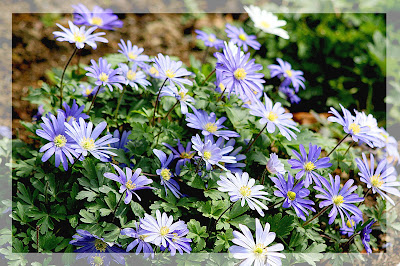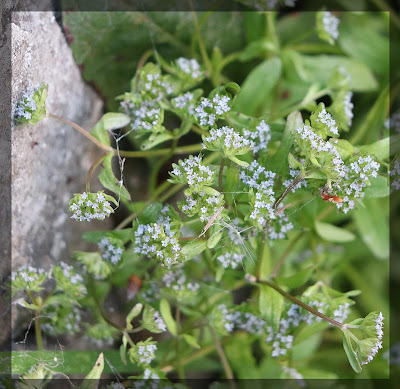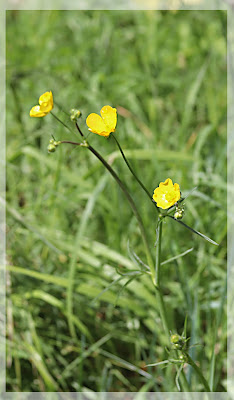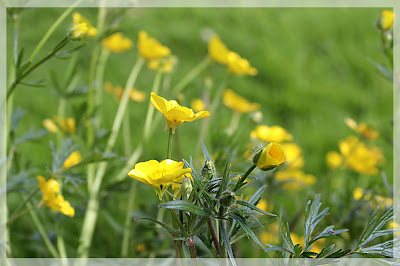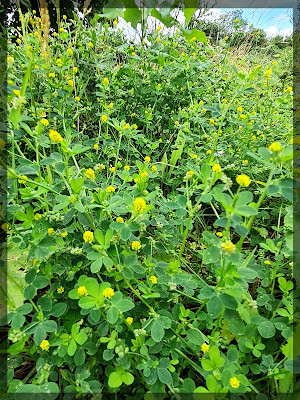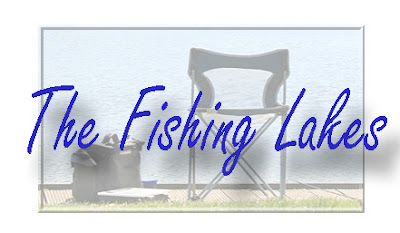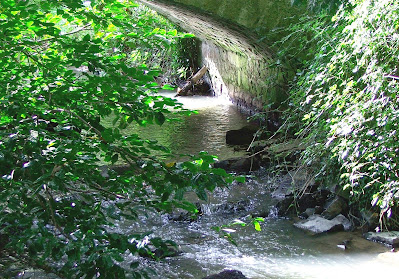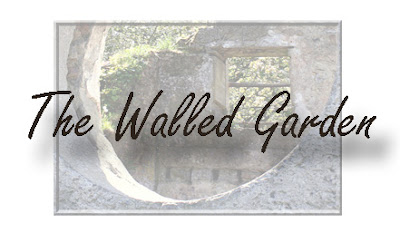Nature at Corkagh: Flowers
Corkagh is home to a wide variety of wildflowers. In addition there are some garden flowers which have become naturalised in parts of the park.
During 2020/21, as much out of curiosity as anything, I decided to log all the wildflowers I found
growing at Corkagh. I also included flowers that appear to be garden escapes and those on shrubs and trees.
Below are most of the flowers that can be found in the park with a little information on each. How many can you spot on your walks?
Flowering in late Winter/Spring
 |
| Daffodils were always associated with Easter but they are at their best from mid March when they carpet the park in vivid yellow. |
〰〰〰
 |
| These lovely little Crocuses begin to flower in February. They can be found beneath the old Copper Beech tree in the Arboretum. |
 |
| Wood Anemone flower from March to May. I found these growing along the stream at the back lane. They are also called 'wind flowers' as their stems bend in the breeze. |
〰〰〰
 |
| Primroses are my favourite flower of spring and early summer. There aren't many to be found in Corkagh itself and these were hidden beneath an ancient hedgerow in an adjacent field. |
 |
| Lets not forget the lovely Daisy. The flower blooms from the lengthening days of March to the chilly afternoons of October. I wonder if kids today still make daisy chains? |
 |
| Veronica Speedwell. This tiny plant grows close to the grass and its blueish flowers are sometimes missed. This photo was taken in the arboretum in early April. |
 |
| Germander Speedwell. This plant is very similar to Field Speedwell but is taller and flowers from April to June. Clusters of flowers grow along the hedgerows. Photo June 8 2021 |
 |
| Leopards Bane is a garden escape which flowers from late spring to early summer. |
 |
| Leopards Bane growing near the estate buildings in early May. |
 |
| Hogweed. Hedgerow near Swan lake, June 8 |
〰〰〰
Flowering from Early to late Summer
 |
| Lambs Lettuce flowers from April to August. Photo: 11/5/21 |
〰〰〰
 |
| Herb Robert with its perfect pink flowers and reddish stems can be found growing along the ancient walls and hedgerows of Corkagh from late spring to autumn. April 2020 |
〰〰〰
〰〰〰
〰〰〰
〰〰〰
〰〰〰
Hawksbeard will grow in most soils and so is found everywhere throughout the
〰〰〰
〰〰〰
〰〰〰
〰〰〰
〰〰〰
〰〰〰
 |
| Bluebells grow along the back lane at Corkagh and make their appearance in mid April. |
 |
| Bluebells can be found under some of the mature trees near the rose garden |
 |
| This beautifully scented Lilac bush can be found in the hedgerow surrounding the arboretum. However it only blooms for a couple of weeks in early summer. |
 |
| The name Herb Bennett is a corruption of the latin term Herba Benedictus or Blessed Herb. It was believed that a sprig of this hung on a door would drive away evil spirits. |
 |
| Blue Water Speedwell. I was surprised to find this lovely little plant growing on hard baked soil behind the Walled Gardens. June 6 |
 |
| Brooklime. This is a relation of the Speedwell flowers and normally grows on wet soil near the lakes edge but this time I found it on the hard baked clay behind the Walled Garden. June 6 |
 |
| Ox-eye Daisy. A lovely tall daisy. Growing at the rear of the Walled Gardens. June 6 |
 |
| Red clover close up |
 |
| Red Clover flowers are made up of individual florets which can be seen clearly in this photo taken July 13th at playing fields adjacent to Grange Castle Road. |
〰〰〰
 |
| Woody Nightshade is also known as Bittersweet. The attractive berries are very poisonous and should be avoided. Photo: July 26th |
〰〰〰
 |
| Common Vetch. Flowers April to Oct. One of the most common flowers in Corkagh it can be found along the hedgerows. This plant is rich in nectar and attracts bees. |
 |
| By August the Vetch plants have scrambled up though nettles and other tall plants and can be seen throughout the park. The flowers are magnificent close up. |
 |
| Germander Speedwell is a tiny flower of grass and hedgerows however its lovely blue colour makes it easy to spot. It blooms from May to July. |
〰〰〰
 |
| Meadow Buttercup: September 1st |
〰〰〰
〰〰〰
〰〰〰
 |
| Elderberries. The berries of the Elder bush are used as a colouring. They are poisonous if consumed raw. Photo: August 24th |
〰〰〰
〰〰〰
Flowering from Mid Summer
 |
| Flowering Rush. This plant is native but uncommon so I was lucky to find it growing at the Fishing/upper lakes in June 2023. |
 |
Hedge Woundwort: This plant can be found in the hedgerows that fringe the park. A poultice made of fresh bruised woundwort can be used to help wounds heal, hence the name.
 |
| Pyramidal Orchid. A single plant was in bloom in the hedgerow on the park side of the Kilcarbery Grange development opposite the Baseball pitch. A really lovely native flower and not too common. |
 |
| Hemp Agrimony. Regardless of the name this plant is not a member of the Cannabis family. I found it growing in the Walled garden in June. |
 |
| Blackberry flowers/ Briar Roses grow in bushes known as brambles. This photo was taken near the fishing lakes June 16th, by September they will have ripened into juicy blackberries ready for picking. |
〰〰〰
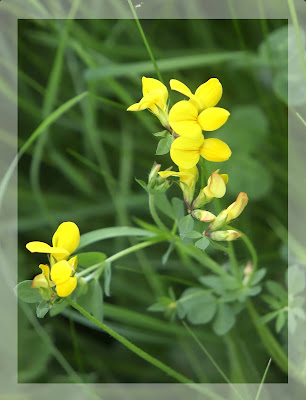 |
| Birdsfoot Trefoil: Photo June 12 |
〰〰〰
 |
| Hedge Mustard. This is a tall spindly plant of hedgerows and waste ground. The flowers are quite small and easy to miss however they provide an important food source for caterpillars of the Small White and Orange Tip Butterflies. Photo June 12th. |
〰〰〰
 |
| Hawksbeard is a plant of rough ground and hedgerows. The flowers are similar to Dandelions but the plant is tall and untidy looking. June 12 |
Hawksbeard will grow in most soils and so is found everywhere throughout the
 |
| Hawksbeard seed heads. Though the flowers are similar to Dandelions these plants are members of the Sunflower family. Photo July 20th. |
〰〰〰
 |
Greater Stitchwort is small but easily visible among the hedgerows in April to June. Like many other wild plants it has been used in traditional herbal medicine. |
 |
| Three Cornered Garlic. This edible plant flowers from spring to early summer. I photographed this flower alongside the stream at the back lane in early May. |
 |
| Wild Garlic also known as Ramsons can be found growing along the back lane during May. 〰〰〰 |
 | |||||
〰〰〰
〰〰〰 |
 |
| Yellow Iris can be seen in flower near the edge of the fishing lakes from late May to August. The plant is invasive and can quickly spread pushing out other aquatic plants however this doesn't seem to be an issue at Corkagh |
 |
| Yellow Iris is also known as Yellow Flag. Photo: Fishing Lakes June 12th. |
〰〰〰
 |
| Sticklebacks growing by the fishing lakes. Who doesn't remember this plant from childhood games. It is covered in tiny prickles which allow it to cling to other plants as it grows over them. The prickles also enable the plant to stick to passing animals enabling its seeds to spread far and wide. A clump of this was as good as any paint gun when playing chasing, just fling it at your target and if it sticks thats a hit. |
 |
| The correct name for Sticklebacks is Cleavers. So called because of its ability to cleave or adhere to anything it comes in contact with. Photo taken at the fishing lakes June 16th. |
 |
| Wild Mustard. Sometimes known as Charlock Mustard. This is a tall and unruly looking plant with clusters of tiny yellow flowers growing on tangled wiry stems. It was traditionally used in herbal remedies. It flowers throughout the summer in hedgerows and roadsides. Photo: June 10 |
 |
| Wild mustard flowers close-up. This plant is very similar and a member of the same plant family(Brassicas like cabbage)as Charlock. As a result I cannot be absolutely sure that this plant is not Charlock. Photo taken at the playing fields near Fairview Mills. July 1st |
〰〰〰
 |
| Snowberry. This shrub can be found along some of Corkaghs paths. In summer it is full of tiny pink flowers but it is named after its white berries which are poisonous. |
 |
| Snowberry bushes at the Arboretum June 16th. |
 |
| Cut leafed Cranesbill. This tiny flower could be easily missed. I was surprised to find its a member of the Geranium family. I spotted this plant growing along the edge of the fence surrounding the cycle track June 24th and so far that is the only example I've seen. |
〰〰〰
 |
| Chickweed. This plant can grow to a foot high but the tiny white flowers mean it often goes unnoticed until it turns up as an unwanted guest in your flowerbeds. They can be found along the walls and hedgerows for much of the year but I photographed this one in early June. Apparently this plant is edible and is used in a wide variety of herbal remedies. |
 |
| Chickweed. Photo: July 16th, Hedgerow near fishing lakes. |
〰〰〰
 |
| Tutsan. This small shrub is related to St Johns Wort. It is also known to have medicinal qualities. This plant likes shaded places and flowers between June and August. Photo was taken at the water garden: June 24th |
 |
| Tutsan with berries forming |
 |
| Creeping Thistle. This plant is classed as an invasive weed as it spreads rapidly via its roots. Nonetheless the flowers are a lovely vibrant lilac and it provides food for a variety of insects and bees. Photo: July1st near Blue Bridge. |
 |
| Thistle |
〰〰〰 |
| Ground Elder. This plant is also known as Goutweed or Bishops-weed because it was brought from Europe by monks for medicinal purposes in the middle ages. Ground Elder could be confused with the poisonous Hogweed which is also in flower at the same time but their leaves are quite different. Photo taken along the wall behind Estate buildings July 1st. |
 |
| Willowherb (July-Aug). This is a tall plant and hard to miss. Most plentiful in the woodland near the Caravan Park. |
 |
| Willow Herb spreads easily via roots and seeds and forms spectacular stands of vibrant pink flowers. Photo near Fishing Lakes July 1st |
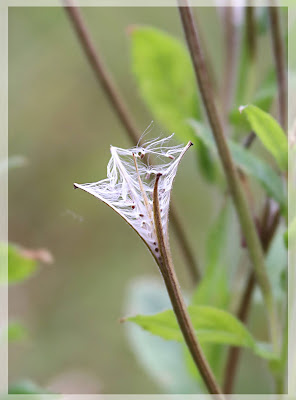 |
| When Willow Herb plants go to seed they can look very unattractive however early in the process they are rather striking. Photo: Sept 1st |
〰〰〰
 |
| Meadowsweet (flowers June to Sept) near the blue bridge. This plant was used to flavour the Gaelic liquor called Mead. Bunches of this fragrant plant would be strewn on floors to give the room a pleasant smell. I understand that the flowers can also be used in place of elderflower in cookery and it has many positive medicinal effects. It is also a plant from which Aspirin can be derived. |
 |
| Meadowsweet going to seed. Photo September 3rd |
〰〰〰
 |
| Wild Cyclamen can be found in shady areas. I've seen plenty this Sept 2020, in hedgerows and under the old trees near the arboretum. |
〰〰〰
 |
| Selfheal. This tiny plant of short grass is widespread in the park and could easily be mistaken for clover. It flowers throughout the summer and is considered an annoying weed when it spreads though lawns. Actually this little plant has medicinal properties and was used as a cure for sore throats. Photo: July 3rd |
 |
| Hedge Bindweed is a fast growing plant and one that is difficult to eradicate. Its stems wind their way around other plants as it spreads. This plant has been used in traditional herbal remedies. This photo taken July 3rd near the fishing lakes. |
 |
| Turks Head Lily. This plant is definitely a 'garden escape' but it appears to be thriving amid the long grass and nettles near the wooden bridge. Absolutely beautiful! 4th July |
 |
| Field Rose. This wild rose blooms in July and the flowers are really pretty when viewed close up. Photo taken at hedgerow between arboretum and playground July 4th |
 |
| Hedge Woundwort. Its tiny flowers mean this plant could be easily missed. Look closely however and they are very pretty. The white markings on the petals serve to direct bees towards the nectar. The flowers smell unpleasant if crushed however a poultice of this plant was said to clean wounds. It can be found growing here and there among taller plants at the edge of hedgerows. Photo: July 6th. |
 |
| Flax also known as Linseed. This plant has been cultivated for centuries. Its seeds are used to make linseed oil and the plant fibres are used to make, among other things, cigarette papers and banknotes. |
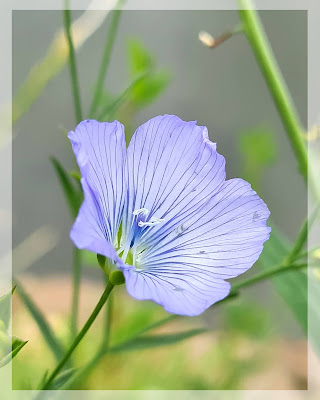 |
| While Flax occurs naturally in Ireland some plants are spread via bird seed mixes. The flower is stunning when viewed close up. I found this plant growing at the edge of Swan Lake on July 7th and haven't found it elsewhere in the park. |
 |
| Common Knapweed. This plant looks very much like a Thistle but without the spiky leaves. It is growing in abundance around the lakes and is popular with butterflies. Photo July 13th near Blue Bridge. |
 |
| Meadow Vetch also called Meadow Pea or Yellow Pea. This plant was once grown for fodder. The markings on the petals are to guide bees towards the nectar. This little plant grows on the edge of hedgerows. It could be confused with a similar flower Birdsfoot Trefoil, but Vetch has longer narrower leaves. Photo: July 13th near blue bridge. |
 |
| Ragwort. This plant is poisonous to cattle and horses though they would rarely eat it, however it is when the plant becomes mixed with silage or hay that this becomes an issue. This is a tall straggling plant of verges and waste ground. It is the national flower of the Isle of Man. Photo: July 12th growing along railings separating park from Kilcarberry Grange development. |
〰〰〰
 |
| Spear Thistle A tall plant of hedgerows and verges. While the prickly leaves and bracts (beneath the flower head) might seem off-putting the flower itself is very pretty with white tips and feels soft. The flower is in fact made up of many tiny florets. |
 |
| Spear Thistle is the national flower of Scotland. Apparently if the flower heads and spikey bracts beneath are removed there is a central core which can be eaten. I wont be trying that myself though!!! Photo July 13th |
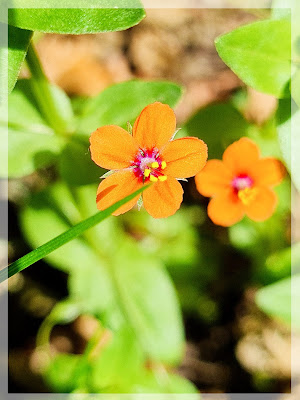 |
| Scarlet Pimpernel. I wondered how I'd missed this gorgeous little flower that is growing under the hedge in front of the toilet block. A quick search online revealed the answer: this flower closes when the weather turns bad, for this reason it was known as Shepherds Weather Glass. But even on sunny days the flowers only stay open till afternoon. No wonder I missed it! Photo: July 16th |
 |
| Scarlet Pimpernel, behind Walled Garden Sept 5th |
〰〰〰
 |
| Ladies Bedstraw. This plant has clusters of tiny yellow flowers which apparently smell like new mown hay when dried. In the past they were used to stuff mattresses particularly for women about to give birth. Photo: hedgerow near rose garden July 16th. |
 |
| Ladies Bedstraw with its feathery yellow flowers. |
 |
| Short fruited Willowherb. Another flower that could easily go unnoticed with its tiny flowers. It is supposed to favour damp places but I found it growing near the rose garden. July 16th |
 |
| Short Fruited Willow Herb: September 1st |
 |
| Short Fruited or American Willowherb? Growing in front of toilet block. Flowers tiny, plant about 5 inches tall. Sept 3rd |
〰〰〰
 |
| White Ramping Fumitory. That's quite a name for such a tiny flower. From a distance you would hardly recognise it as a flower at all nor imagine that its a member of the poppy family! Apparently it's more common in coastal locations. I photographed this along the hedge in front of toilet block. July 16th |
 |
| White Ramping Fumitory. While its flowers are quite undistinguished the delicately shaped leaves are quite distinctive. |
 |
| White Ramping Fumitory: a big name for a small plant. Photo: September 2nd. |
〰〰〰
 |
| Common Fumitory. This plant has been used in folk medicine for skin complaints and eye conditions. |
 |
| Common Fumitory leaves. This photo was taken in grassy verge at the rear of the Baseball field August 8th. |
 |
| Common Fumitory |
〰〰〰
 |
| Figwort. This plant was traditionally used in herbal medicine for many purposes including as a cure for skin problems. While the plant itself can grow to 1m tall the flowers are tiny. Photographed in tall vegetation near wooden bridge opposite estate cottages. July 16th |
 |
| Figwort seed pods. Photo: Grassy verge at rear of Baseball field August 8th |
〰〰〰
〰〰〰
〰〰〰
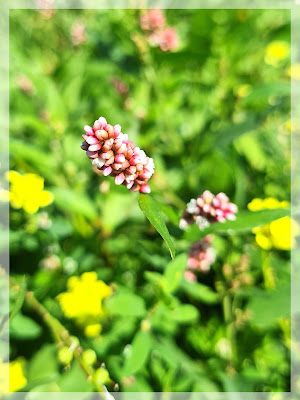 |
| Redshank. Apparently this little plant is common but I've only spotted it in one place so far. It is considered a nuisance weed when found among crops but the clusters of pink flowers are very pretty and I'd be happy to have it pop up in my garden. |
 |
| Redshank seeds are popular with small wild birds. The plant is used in herbal medicine and can be found in damp areas. Ive seen this plant growing in waste ground beside the Walled garden (August) and this photo taken close to bridge over Camac at Fairview Mills. July 19th. -Redshank can be found throughout the park in August.- |
 |
| Lesser Stitchwort. Even though this plant can grow up to 18 inches the white star like flowers are small. Close up these blooms really have the wow factor and all the more because the flower only blooms for 3 days. This plant grows throughout summer among the long grasses at the edge of hedgerows. Photo: July 18th near Mill Pond. |
 |
| Nipplewort. So called because the flower buds look like...! This plant has been used in herbal medicine and the young leaves can be eaten in place of spinach. Photo 20th July near Camac bridge/fishing lakes |
 |
| Nipplewort. Photo: near entrance to Fairview Mills. August 14th |
〰〰〰
〰〰〰
 |
| Bristly Oxtongue also known as Prickly Oxtongue. This plant is rare outside of the Eastern part of Ireland. It was used in herbal medicine as a treatment for worms. |
 |
| Bristly Oxtongue is quite a forbidding looking plant with such spiny leaves. Photo 20th July beside Mill pond. |
 |
| Angelica. This plant has umbels of white flowers with a pink tinge. It looks similar to Hogweed and Hemlock but unlike them Angelica is not poisonous. In fact this plant is a popular flavouring in many liquors and is also widely used for medicinal purposes. |
 |
| Angelica growing along the old wall at the back of the estate buildings. Photo: 3rd August. |
 |
| Teasel. This is a tall plant with Thistle like flowers which I found growing near the old Walled Garden. Teasel is visited by many bees and insects and in Autumn its seeds are attractive to birds particularly the colourful Goldfinch. Photo: August 3rd |
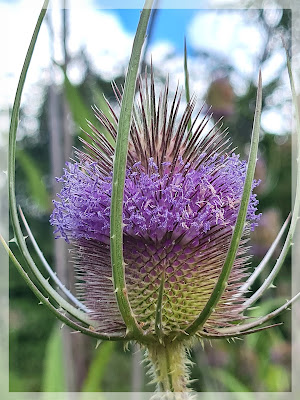 |
| The prickly spines of the Teasel flowers were once used to comb woollen cloth being gentler than a metal comb. While this plant is normally found growing wild it is increasingly popular as an ornamental plant in gardens. |
 |
| Mayweed. This plant with its Daisy like flowers and feathery leaves can be found growing in profusion on the waste ground near the entrance to the Walled Garden. |
 |
| Mayweed. Photo: August 3rd |
 |
| Meadow Crane's-Bill. The striking violet blue flowers ripen to pointed bill like seed pods hence the name. This plant is a member of the Geranium family and is often included in wild flower seed mixes. |
 |
| Meadow Crane's-Bill seed pods. |
 |
| I photographed this Meadow Crane's-Bill in the field behind the estate buildings, near the woodland walk. August 8th. |
 |
| Lesser Burdock is a member of the Thistle family of plants. The 'burrs' which contain the seeds attach themselves to animals fur and so spread. This plant is also used widely in herbal medicine particularly for the treatment of skin complaints. |
 |
| A Swedish engineer, when removing the burrs of this plant from his dogs fur and his own clothing, decided to replicate them and thus Lesser Burdock became the inspiration behind Velcro which was invented in the 1940s. I photographed this plant in the field behind Estate buildings August 8th. |
〰〰〰
 |
| Red Bartsia. This straggly plant of hedgerows and verges has tiny pink/purple flowers. |
 |
| I photographed this Red Bartsia in a grassy verge at the back of the Baseball field. August 8th |
 |
| Red Bartsia growing in profusion at playing fields next to the allotments. August 16th |
〰〰〰
 |
| Black Medick has been used as Shamrock in the past as it's a member of the Clover family. Apparently this plant is favoured in the making of honey. Photo taken in waste ground behind Walled Garden August 8th. |
Black Medic growing in profusion behind the Walled Gardens.
〰〰〰
 |
| Fat Hen also known as Lambs Quarters or White Goosefoot. This tall plant is a popular nibble for hens (hence the name) and was also used as a foodstuff being ground up as a sort of porridge. The leaves have also been used like spinach or kale. You would hardly recognise the flowers as such since they have no petals. Photo: waste ground at rear of Walled Garden August 8th |
 |
| Water Mint. This plant, as its name implies, grows close to, or sometimes in, water. It has a strong peppermint flavour and the leaves can be used as a herbal tea. The Romans used it to scent their homes and baths. It is widely used in herbal medicine. |
 |
| I found Water Mint growing along the wooden platforms at the Fishing lakes and also in the weirs there. Photo: August 8th. |
 |
| Water Mint |
〰〰〰
 |
| St Johns Wort. A well known plant which is used to treat anxiety and here it is growing in Corkagh. Photo taken at the hedgerow between estate cottages and the small stream/wooden bridge. August 8th |
 |
| St Johns Wort |
 |
| Yarrow. This low growing plant with its umbels of creamy flowers is easily recognised by its unusual feather shaped leaves. Photo was taken near Fairview Mills bridge August 14th. |
 |
| Yarrow was used from ancient times to staunch the flow of blood from injuries and was used on the battlefield by ancient Greeks and Romans. |
〰〰〰
 |
| Wild Poppy. An individual poppy flower only lasts for one day but you'd hardly notice as a single plant can produce many flowers one after the other. A plant can also produce up to 50,000 seeds! In Irish lore the poppy was known as the Witches Flower Photo: Near Fairview Mills bridge, August 14th. |
Groundsel. The flowers of this plant are absolutely tiny (they have no petals)
and easily missed. This plant was used in folk medicine for
making poultices and curing headaches. Groundsel flowers throughout the year.
Photo: Hedge in front of toilet block. August 17th
〰〰〰
 |
| Prickly Sow thistle. While its flower looks very like a dandelion the leaves are more like those of the thistle. |
are best picked when young and of course the spines have to be
removed!! This plant has been used in herbal medicine to treat
a wide variety of ailments and an infusion
of the roots and leaves made a good tonic.
Photo: Near Fairview Mills/Kavanaghs Bridge, August 16th.
〰〰〰
〰〰〰
 |
| Wavy Bitter Cress has the tiniest white flowers and is another plant that is easy to miss. The leaves are quite distinctive though. Just as its name indicates, its leaves are edible and taste like bitter Cress. Photo: hedgerow near mill pond. August 16th |
〰〰〰
 |
| Himalayan Balsam. This tall plant is native to the Himalayas but now widespread across Europe. It was introduced as a garden plant but is now considered an invasive species as it spreads quickly and grows up to 3m tall. I photographed this plant growing on the Camac bank at the fishing lakes near the Grange Castle Road Car park. August 24th |
 |
| Himalayan Balsam. |
〰〰〰
 |
| Water Speedwell is a native plant of wetlands and riverbanks. |
 |
| The leaves of Water Speedwell are said to be edible. |
 |
| Water Speedwell grows in several areas around the fishing lakes Photo: September 1st near coffee shop. |
〰〰〰
 |
| Lords and Ladies. This plant actually flowers in Spring but the flowers are hardly recognisable as such. The berries, though, add a splash of colour to the woodland floor. Beware: The berries are poisonous and the leaves and roots can cause blistering of the skin. Photo: August 24th |
〰〰〰
 |
| Periwinkle These are generally garden escapes but since their stalks root wherever they touch ground this plant can spread quickly. Normally it flowers in Spring but it can have a few flowers throughout the season. I photographed this flower near the bungalow at the St Johns Wood Carpark so it may actually have been planted there. August 24th |
〰〰〰
 |
| Tufted Vetch. This tall plant winds itself around other plants and grasses and can grow to 1.5m. It is a member of the Pea family and has been grown as fodder for animals. Like other members of the Vetch family it helps enrich the soil in which it grows. |
 |
| Tufted Vetch I hadn't noticed these flowers before (possibly assuming it was common vetch) but the plants seems to have grown rapidly to over 3ft in the space of a few days and have spread through the grass. Photo: Long grass opposite fishing lakes; Sept 1st |
 |
| The attractive leaves of Tufted Vetch with their curling tendrils at the top. They use these to cling to other plants. |
〰〰〰
 |
| Red Dead Nettle. This is a tiny plant which grows for much of the year but the flowers are so small it is easy to miss. So called because the leaves look like those of nettles but they don't sting. |
 |
| Red Dead Nettle: Photo in hedge at front of toilet block. Sept 3rd |
〰〰〰
 |
| Shepherds Purse. This plant with its tiny flowers grows for much of the year and is a common weed found in gardens and waste ground. It was once thought that the sap could help ear complaints. |
 |
| Shepherds Purse; Photo at hedge in front of toilet block: Sept 5th |
〰〰〰
 |
| Watercress. This edible plant with its sparse clusters of tiny white flowers is growing in the outflow from the fishing lake to the Camac. It is quite inaccessible there but there may be more of it growing near the mill pond. I met a Chinese family who were collecting this near the Mill Pond a few years back and while I was surprised to see them picking it they seemed equally surprised that I didn't realise its value. Photo: 20th September |
〰〰〰
 |
| Knotgrass. This plant has tiny flowers, less than 2cm and so easily missed. It has long been used in herbal medicine to cure everything from insect bites to dysentery. This plant is also used to make dyes. Interestingly Knotgrass seeds were found during excavations of the Viking settlement at Wood Quay and it is thought that its brown seeds were used to make porridge. |
 |
| Knotgrass. Photo: near Kavanaghs Bridge/Oilmills September 24th. |
〰〰〰
 |
| Petty Spurge: This low growing plant is easily missed except for its leaves which appear to have a yellow variegation The flowers are so tiny they are difficult to see with the naked eye. |
 |
| This plant is also known as Milkweed because of the white latex that is contained within its stems. This latex is very caustic and will damage the skin on contact. In fact the latex from Spurge is a key ingredient in some wart removers. Photo: Base of wall behind estate buildings 18th October |







